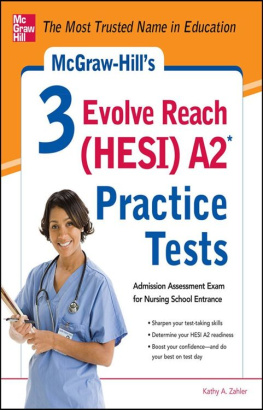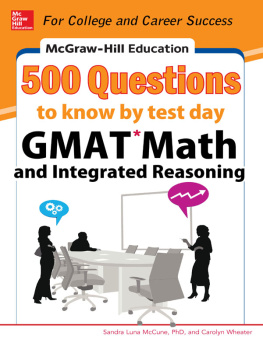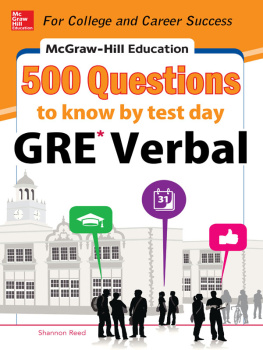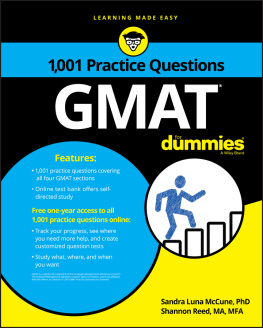McGraw-Hill Education
500
GMAT Verbal
Questions
to know by test day
McGraw-Hill Education
500
GMAT Verbal
Questions
to know by test day
Kathy A. Zahler, MS
New York Chicago San Francisco Athens London Madrid
Mexico City Milan New Delhi Singapore Sydney Toronto
Copyright 2014 by McGraw-Hill Education. All rights reserved. Except as permitted under the United States Copyright Act of 1976, no part of this publication may be reproduced or distributed in any form or by any means, or stored in a database or retrieval system, without the prior written permission of the publisher.
ISBN: 978-0-07-181217-7
MHID: 0-07-181217-2
eBook conversion by Cenveo Publisher Services
Version 1.0
The material in this eBook also appears in the print version of this title: ISBN: 978-0-07-181216-0, MHID: 0-07-181216-4.
McGraw-Hill Education eBooks are available at special quantity discounts to use as premiums and sales promotions, or for use in corporate training programs. To contact a representative, please visit the Contact Us page at www.mhprofessional.com.
All trademarks are trademarks of their respective owners. Rather than put a trademark symbol after every occurrence of a trademarked name, we use names in an editorial fashion only, and to the benefit of the trademark owner, with no intention of infringement of the trademark. Where such designations appear in this book, they have been printed with initial caps.
Information has been obtained by McGraw-Hill Education from sources believed to be reliable. However, because of the possibility of human or mechanical error by our sources, McGraw-Hill Education, or others, McGraw-Hill Education does not guarantee the accuracy, adequacy, or completeness of any information and is not responsible for any errors or omissions or the results obtained from the use of such information.
GMAT is a registered trademark of the Graduate Management Admission Council, which was not involved in the production of, and does not endorse, this product.
Interior illustrations by Cenveo
TERMS OF USE
This is a copyrighted work and McGraw-Hill Education and its licensors reserve all rights in and to the work. Use of this work is subject to these terms. Except as permitted under the Copyright Act of 1976 and the right to store and retrieve one copy of the work, you may not decompile, disassemble, reverse engineer, reproduce, modify, create derivative works based upon, transmit, distribute, disseminate, sell, publish or sublicense the work or any part of it without McGraw-Hill Educations prior consent. You may use the work for your own noncommercial and personal use; any other use of the work is strictly prohibited. Your right to use the work may be terminated if you fail to comply with these terms.
THE WORK IS PROVIDED AS IS. McGRAW-HILL EDUCATION AND ITS LICENSORS MAKE NO GUARANTEES OR WARRANTIES AS TO THE ACCURACY, ADEQUACY OR COMPLETENESS OF OR RESULTS TO BE OBTAINED FROM USING THE WORK, INCLUDING ANY INFORMATION THAT CAN BE ACCESSED THROUGH THE WORK VIA HYPERLINK OR OTHERWISE, AND EXPRESSLY DISCLAIM ANY WARRANTY, EXPRESS OR IMPLIED, INCLUDING BUT NOT LIMITED TO IMPLIED WARRANTIES OF MERCHANTABILITY OR FITNESS FOR A PARTICULAR PURPOSE. McGraw-Hill Education and its licensors do not warrant or guarantee that the functions contained in the work will meet your requirements or that its operation will be uninterrupted or error free. Neither McGraw-Hill Education nor its licensors shall be liable to you or anyone else for any inaccuracy, error or omission, regardless of cause, in the work or for any damages resulting therefrom. McGraw-Hill Education has no responsibility for the content of any information accessed through the work. Under no circumstances shall McGraw-Hill Education and/or its licensors be liable for any indirect, incidental, special, punitive, consequential or similar damages that result from the use of or inability to use the work, even if any of them has been advised of the possibility of such damages. This limitation of liability shall apply to any claim or cause whatsoever whether such claim or cause arises in contract, tort or otherwise.
CONTENTS
Questions 1165
Questions 166310
Questions 311490
Questions 491500
INTRODUCTION
Congratulations! Youve taken a big step toward GMAT success by purchasing McGraw-Hill Education: 500 GMAT Verbal Questions to Know by Test Day. We are here to help you take the next step and score high on your GMAT exam so you can get into the business school of your choice!
This book gives you 500 GMAT-style multiple-choice questions that cover all the most essential course material on the verbal section as well as the analytical writing assessment. Each question is clearly explained in the answer key. The questions will give you valuable independent practice to supplement any earlier review you may have done.
This book and the others in the series were written by expert teachers who know the subject inside and out and can identify crucial information as well as the kinds of questions that are most likely to appear on the exam.
You might be the kind of student who needs extra study a few weeks before the exam for a final review. Or you might be the kind of student who puts off preparing until the last minute before the exam. No matter what your preparation style, you will benefit from reviewing these 500 questions, which closely parallel the content, format, and degree of difficulty of the questions on the actual GMAT exam. These questions and the explanations in the answer key are the ideal last-minute study tool for those final weeks before the test.
If you practice with all the questions and answers in this book, we are certain you will build the skills and confidence needed to excel on the GMAT. Good luck!
The Editors of McGraw-Hill Education
PART
Verbal
CHAPTER
Reading Comprehension
The questions in this group are based on the content of a passage. After reading the passage, choose the best answer to each question. Answer all questions following the passage on the basis of what is stated or implied in the passage.
Historians consider General Andrew Jacksons victory over the British at the Battle of New Orleans the greatest land victory of the War of 1812. The victory ensured Americas sovereignty over the Louisiana Territory, which in turn led to a wave of new settlement in that area.
Today the battlefield is preserved as a tourist attraction. It features a monument whose cornerstone was laid in 1840 after Jackson visited the field on the 25th anniversary of the battle. Chalmette National Cemetery is also on the site. It houses the remains of only one veteran of the Battle of New Orleans; it is mainly for veterans of the Civil War (on the Union side), the Spanish-American War, World Wars I and II, and the Vietnam conflict.
Like all good historical restorations and most of our national historical parks, this one conjures up the history it celebrates. Visitors to the site may gain a panoramic view of the field of battle, with large reproductions of American cannons still fixed at several batteries and the front lines clearly visible. On the left, tourists may envision Colonel Robert Rennies attack, which briefly overtook the American rampart. In the center, small-arms fire tore through the British Highlanders troops. On the right, the brigade run by General Samuel Gibbs came to grief under fire from General John Coffees Tennessean troops.
. Which of the following conclusions may be drawn directly from the first paragraph of the passage?







